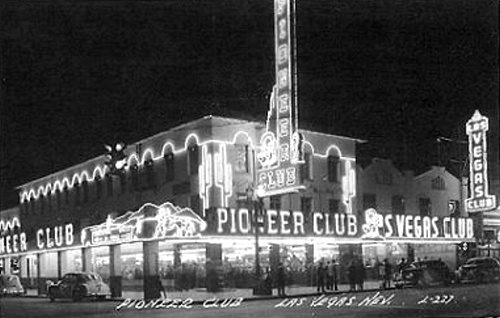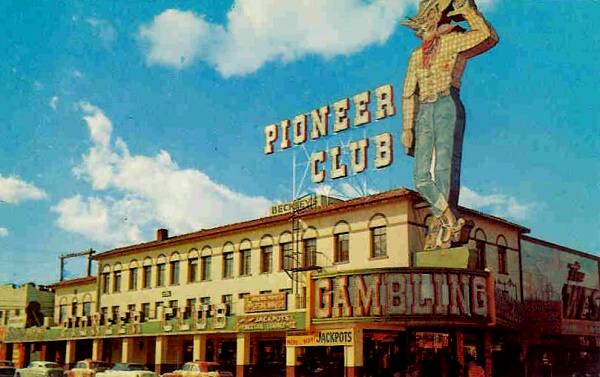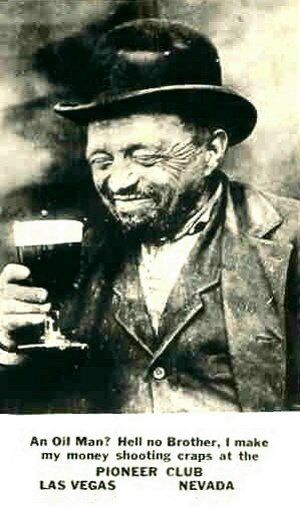
Photo from the Mark Englebretson Collection

Photo from the Barry Hauptman Collection
| Pioneer Club |
| 25 Fremont Street |
| 1942 - 1995 |
 Photo from the Mark Englebretson Collection |
 Photo from the Barry Hauptman Collection |
The Pioneer Club opened at 25 Fremont Street in 1942. The property it occupied, due to its strategic location at the corner of Fremont and First streets, had of course housed a variety of businesses, in a number of different configurations (encompassing the addresses 21, 23, and 25 Fremont Street) and incarnations since it was first developed in 1905-06 at the dawn of downtown Las Vegas history. Prior to becoming a casino, it's remembered primarily as a tobacco shop called the Smokehouse, and a clothing store owned by Jake and Will Beckley, two brothers and early Las Vegas businessmen who participated in the land auction in May 1905. (Will Beckley was later honored when a Las Vegas elementary school was named after him). In 1929, Will Beckley expanded the building, adding a third story. In 1931, the property became a casino for the first time: the Las Vegas Club. It was opened by J. Kell Houssels, who received the third gambling license ever issued in Clark County. It remained the Las Vegas Club till the early 1940s, when the owner, Kell Houssels, moved it across the street to its present location at the corner of Fremont and Main. In April 1942, California gamblers Chuck Addison and Louis "Tutor" Scherer opened the Pioneer Club in the vacated Las Vegas Club building. (Tutor Scherer was a gambler-poet, a rare breed in that age and, in fact, in any age. He was appointed as Nevada's poet laureate by Gov. Charles Russell in 1950 and self-published Reminiscing in Rhyme in 1956.) Some sources, however, claim that Addison and Scherer were fronts for Bugsy Siegel. The 1942 timing is about right. The famous Vegas Vic was the mascot of the Pioneer Club from the late '40s on. The first of two signs consisted mostly of Vic's face, with a moving neon thumb and neon typography that read, "Here It Is! The Famous Pioneer Club." This sign was replaced in 1951 with the enduring 40-foot-tall neon cowboy, which was erected on the side of the Pioneer Casino in 1951. Manufactured and installed by the Young Electric Sign Company (YESCO) for $25,000, Vic weighed six tons, his arm waved to passers-by, and his cigarette twitched and blew smoke rings. At the time, it was the largest mechanical sign in the world. The Pioneer percolated along as a downtown grind joint till closing in 1956. It soon reopened under the new name of the New Pioneer Club. In 1965 the Pioneer Club purchased the Elwell Hotel, located directly behind the casino at 200 South First Street; it was renamed the Pioneer Hotel. (The Pioneer Hotel was sold off in 1969 and was renamed the Golden Hotel. It lasted through 1984 when it was bought by the Golden Nugget bought the Golden Hotel and turned into a parking garage.) In 1967 Margaret Elardi bought out the Pioneer Club. Margaret and Charles Elardi had run a construction business in California till retiring in Las Vegas in the mid-1960s. Charles Elardi kept busy piloting his own plane, while Margaret saw an opportunity in the casino business. With a little help from legendary Las Vegas banker Parry Thomas, she took over the casino, which had 20 slot machines and nine tables; to keep an eye on the joint, Elardi slept in her office upstairs. (In 1981, Elardi bought the Colorado Casino in Laughlin and renamed it the Pioneer. She installed a tall neon cowboy known as River Ric, which explains the connection between Vic and Ric.) Meanwhile, the Westerner Club next door had been turned into Club Bingo in 1962. Elardi bought Club Bingo in 1983 and used it to expand the Pioneer, which now occupied 23 and 25 E. Fremont. Elardi sold out a little while later and Pioneer Club percolated along as the grind joint it had always been. Deke Castleman remembers the time when he and Anthony Curtis went there to play Caribbean stud for the first time at a dollar table. The only two table-game players in the joint at noon on a weekday, they were discussing the new game, showing each other their cards and trying to figure the whole thing out. Finally, the pit boss came over and admonished the two not to compare cards and notes. Duly chastised over colluding on their dollar bets, they left the casino. On the way out, Anthony commented to Deke, "Obviously, that boss doesn't know that I'm one of the most famous gamblers in the world." The Pioneer Club finally closed for good in 1995 and the building was occupied for many years by a souvenir shop. Today, it's an ABC (Hawaiian) Store. |
 Photo from the Mark Englebretson Collection |